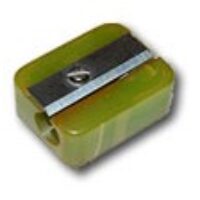
Here are two mains power sockets from around our home. One is a standard grounded 220V socket. The second is obviously much better: in the same space, for the same trouble, it takes two plugs! In the USA this is of course standard practice; all wall socket panels have two sockets. Here, though, this is less common, perhaps because our plugs are larger. So – isn’t that twin socket neat?
 Well, it would have been, if the designer had been thinking. You can see the problem in the next photo: most grounded mains plugs have the cable coming out the side – and this means the second socket in this panel is obstructed by this cable. All it would take to fix this is to build the panel the other way around, with the ground connections on the outside rather than facing the center, or better yet, place the two plugs side by side with the cables going down towards the floor. Cost and complexity of production would have been identical; usefulness would have doubled.
Well, it would have been, if the designer had been thinking. You can see the problem in the next photo: most grounded mains plugs have the cable coming out the side – and this means the second socket in this panel is obstructed by this cable. All it would take to fix this is to build the panel the other way around, with the ground connections on the outside rather than facing the center, or better yet, place the two plugs side by side with the cables going down towards the floor. Cost and complexity of production would have been identical; usefulness would have doubled.
Shame!


 So, I kept accumulating old hard drives from long gone computers… intending one day to take a power drill to their pesky screws, but never getting around to it… until one day I got fed up and solved the problem once and for all.
So, I kept accumulating old hard drives from long gone computers… intending one day to take a power drill to their pesky screws, but never getting around to it… until one day I got fed up and solved the problem once and for all.

 New on my Possibly Interesting site: a weird superhero comic spoof that I drew when I was studying Mathematics in College. It follows closely the style of 60’s Superman comics, but it takes place entirely in the domain of geometrical figures (and no, at that time I hadn’t yet read Abbott’s Flatland). Lost for years, it had surfaced in a drawer of old stuff, and I figured I might as well share it: if you, too, were a comics fan, and a geek to boot, you may enjoy this.
New on my Possibly Interesting site: a weird superhero comic spoof that I drew when I was studying Mathematics in College. It follows closely the style of 60’s Superman comics, but it takes place entirely in the domain of geometrical figures (and no, at that time I hadn’t yet read Abbott’s Flatland). Lost for years, it had surfaced in a drawer of old stuff, and I figured I might as well share it: if you, too, were a comics fan, and a geek to boot, you may enjoy this.
 This would be easy to do at the factory, but when I checked it out today I discovered that it exists as a retrofit: the charmingly named web company iwoot.com (the name stands for I Want One Of Those) sells a “
This would be easy to do at the factory, but when I checked it out today I discovered that it exists as a retrofit: the charmingly named web company iwoot.com (the name stands for I Want One Of Those) sells a “
 So what, you say?
So what, you say?